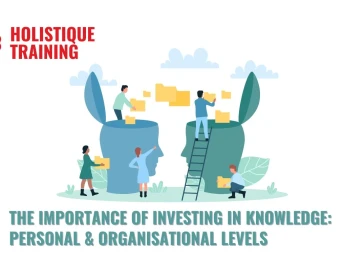- Table of Contents
- Introduction
- Understanding Holacracy in the Workplace
- The Origins and Concept of Holacracy
- How Holacracy Works
- Four Key Elements of Holacracy
- 1- Roles
- 2- Circle Structure
- 3- Governance Processes
- 4- Operational Processes
- The Principles of Holacracy
- Distributed Authority
- Purpose-Driven Work
- Dynamic Roles and Structures
- Transparent Processes
- The Benefits of Holacracy in the Workplace
- Increased Agility
- Enhanced Employee Engagement
- Improved Collaboration and Communication
- Better Alignment with Organisational Goals
- Greater Innovation
- Enhanced Accountability
- Differences Between Holacracy and Traditional Hierarchies
- Structure and Decision-Making
- Role Definition and Flexibility
- Governance and Operational Processes
- Accountability and Performance
- Organisational Culture and Employee Engagement
- Adaptability to Change
- Examples of Holacracy in Different Fields
- Software Development
- Healthcare
- Education
- Non-Profit Organisations
- Creative Industries
- Conclusion
Introduction
In the ever-evolving business landscape, traditional management structures are often challenged by the need for greater flexibility, faster decision-making, and enhanced employee engagement. One innovative solution that has gained traction in recent years is Holacracy. This revolutionary organisational model shifts away from conventional hierarchies and introduces a distributed authority and self-management system. Holacracy aims to create more agile, responsive, and empowered organisations by redefining roles, fostering transparency, and emphasising purpose-driven work. This blog post delves into the intricacies of Holacracy, exploring its origins, key elements, principles, benefits, and practical examples across various fields.
Understanding Holacracy in the Workplace
Holacracy represents a transformative approach to organisational management and structure. Moving away from the traditional hierarchical framework, it introduces a decentralised system where decision-making is distributed throughout self-organising teams rather than being concentrated at the top. This innovative model aims to foster agility, transparency, and employee empowerment.
The Origins and Concept of Holacracy
Holacracy was conceived by Brian Robertson, a former software developer, who sought a more efficient and dynamic way of organising work. The term itself combines "holarchy," which refers to a system composed of holons (autonomous units), with "cracy," denoting governance. Holacracy, thus, can be understood as governance by self-organising units.
Robertson’s experiences in traditional corporate environments highlighted inefficiencies and a lack of responsiveness to change. Inspired by his insights, he foundedHolacracyOne in 2007, aiming to provide organisations with a robust framework for self-management. Holacracy empowers individuals by granting them defined roles and responsibilities within a flexible and adaptive structure.
How Holacracy Works
At its core, Holacracy operates through a system of roles and circles rather than job titles and departments. Each role is a set of responsibilities and duties assigned to an individual, while circles are groups of roles that collaborate to achieve specific objectives. These circles are semi-autonomous, allowing for decentralised decision-making.
A key feature of Holacracy is its structured processes for governance and operations. Governance meetings focus on role assignments, policies, and the evolving structure of circles, ensuring clarity and alignment with the organisation’s purpose. On the other hand, operational meetings deal with day-to-day tasks and projects, fostering an environment of continuous feedback and adaptation.
Four Key Elements of Holacracy
Holacracy's unique framework is built upon several fundamental elements, each contributing to the overall functionality and fluidity of the system. These elements work together to create an environment where decision-making is decentralised, roles are clearly defined, and the organisation can adapt quickly to changes.
1- Roles
In a holacratic organisation, roles replace traditional job descriptions. Each role is a set of responsibilities and accountabilities, allowing individuals to focus on specific tasks that contribute to the organisation's goals. The governance process defines roles and can be adjusted as needed, providing a dynamic and flexible approach to work.
The clarity provided by well-defined roles reduces ambiguity and ensures that everyone understands their contributions to the organisation's success. This clear delineation helps to avoid overlaps and gaps in responsibilities, making the organisation more efficient. Moreover, the dynamic nature of roles allows for rapid adaptation to changing circumstances, ensuring that the organisation remains agile and responsive.
2- Circle Structure
Circles are the building blocks of a holacratic organisation. Each circle operates semi-autonomously, with its own set of roles and responsibilities aligned to achieve specific outcomes. Circles can contain sub-circles, creating a nested structure that allows for scalability and complexity.
This circle structure ensures that decision-making is distributed throughout the organisation, promoting autonomy and empowerment at all levels. Each circle has the authority to govern itself, set policies, and manage its operations within the boundaries of its defined purpose. This decentralised approach reduces bottlenecks and increases the organisation's ability to respond swiftly to opportunities and challenges.
3- Governance Processes
Governance processes in Holacracy are designed to maintain clarity and alignment within the organisation. Governance meetings are held regularly within each circle to review and update roles, policies, and the structure itself. This process ensures the organisation can adapt to changing circumstances without losing coherence or direction.
Members propose changes to roles, policies, or circle structures during governance meetings. These proposals are discussed and refined collaboratively, ensuring all voices are heard and considered. This inclusive approach to governance fosters a sense of ownership and engagement among employees, as they directly influence the organisation's evolution.
4- Operational Processes
Operational processes focus on the day-to-day activities and project management within circles. These processes include tactical meetings where circle members discuss ongoing work, address obstacles, and allocate resources. This approach fosters a culture of transparency and collaboration, ensuring that everyone is aligned and informed about the current state of operations.
Tactical meetings are typically short and focused, designed to address immediate issues and keep projects moving forward. They provide a platform for continuous feedback and iteration, allowing teams to adapt quickly to new information or changing priorities. This ongoing communication helps to maintain momentum and ensures that the organisation's efforts are consistently aligned with its goals.
The Principles of Holacracy
Holacracy is underpinned by several core principles that differentiate it from traditional management structures and guide its implementation. These principles serve as the foundation for the system, ensuring that it remains flexible, transparent, and purpose-driven.
Distributed Authority
One of the most significant principles of Holacracy is the distribution of authority. Traditional hierarchical organisations centralised decision-making power at the top, often leading to bottlenecks and slow responses to change. In contrast, Holacracy disperses decision-making authority throughout the organisation, empowering individuals at all levels to take ownership of their roles and make decisions relevant to their responsibilities.
This authority distribution is achieved by defining clear roles and governance processes. Each role has the autonomy to make decisions within its domain, which reduces the need for constant approval from higher-ups and speeds up the decision-making process. This empowerment can increase innovation and responsiveness, as employees can act quickly and independently.
Purpose-Driven Work
Holacracy strongly emphasises purpose. Every role, circle, and policy is aligned with the broader organisational purpose, ensuring that all actions and decisions contribute to the overall mission. This focus on purpose helps unify the organisation and provides a clear direction for all activities.
Aligning work with purpose also enhances employee engagement and motivation. When individuals understand how their roles contribute to the organisation's larger goals, they are more likely to feel a sense of fulfilment and commitment. This sense of purpose can drive higher levels of productivity and job satisfaction, creating a more positive and effective work environment.
Dynamic Roles and Structures
In contrast to rigid job titles and departmental boundaries, Holacracy embraces dynamic roles and fluid structures. Roles can be redefined and adjusted as needed, allowing the organisation to remain agile and responsive to change. This adaptability is crucial in fast-paced environments where the ability to pivot quickly can be a significant competitive advantage.
Dynamic roles mean that individuals are not confined to a single, static job description. Instead, they can take on different responsibilities and evolve their roles as the organisation's needs change. This flexibility allows for continuous improvement and innovation, as roles can be fine-tuned to better align with emerging opportunities and challenges.
Transparent Processes
Transparency is a cornerstone of Holacracy. All governance and operational processes are conducted openly, with clear documentation accessible to everyone within the organisation. This openness builds trust and ensures that everyone is informed and aligned, reducing misunderstandings and fostering a culture of collaboration.
Transparent processes mean that all decisions, role assignments, and policy changes are documented and available for review. This visibility ensures accountability and allows employees to understand the rationale behind decisions. It also facilitates better communication and coordination, as everyone can access the same information and work towards common goals.
KPI | Description | Measurement |
Role Clarity | Defined responsibilities and domains | Role documentation and feedback |
Decision Efficiency | Speed of decision-making processes | Time to resolution |
Team Collaboration | Effective teamwork within circles | Peer reviews and project outcomes |
Accountability Adherence | Meeting role-based responsibilities | Performance against defined accountabilities |
Continuous Improvement | Adaptation and process enhancements | Implementation of role/policy changes |
Table: Key Performance Indicators (KPIs) of a manager in a holacracy
The Benefits of Holacracy in the Workplace
As stated on Holacracy's official website, over 1,000 companies worldwide have adopted the Holacracy approach, which speaks volumes about its benefits for organisations willing to embrace an unconventional approach. Each benefit creates a more dynamic, responsive, and engaged work environment. Let’s discuss each in detail:
Increased Agility
Holacracy's flexible structure allows organisations to respond swiftly to market or internal environment changes. Unlike traditional hierarchies that can be slow to adapt due to rigid structures and layers of approval, Holacracy empowers teams and individuals to make decisions quickly. This ability to redefine roles and restructure circles as needed means that the organisation can pivot and respond to new opportunities or challenges with minimal disruption. This agility is particularly valuable in fast-paced industries where the competitive landscape constantly evolves, and the ability to innovate and react swiftly can be a critical advantage.
Enhanced Employee Engagement
Holacracy fosters a sense of ownership andengagement among employees. When employees understand their specific responsibilities and have the autonomy to make decisions by empowering individuals with clear roles and decision-making authority, they are more likely to feel invested in their work and motivated to perform at their best. This sense of ownership can lead to higher levels of job satisfaction and a deeper commitment to the organisation’s goals. Moreover, the transparency and inclusiveness of governance processes ensure that employees feel their voices are heard and valued, further enhancing their engagement and loyalty to the company.
Improved Collaboration and Communication
The transparency and structured processes of Holacracy enhance communication and collaboration across the organisation. Regular meetings and open documentation ensure that everyone is informed and aligned, reducing silos and promoting teamwork. This open flow of information helps to break down barriers between different teams and departments, fostering a culture of collaboration where knowledge and ideas can be freely exchanged. Additionally, clearly defining roles and responsibilities minimises confusion and overlap, making it easier for teams to coordinate their efforts and work together towards common objectives. This improved collaboration can lead to more innovative solutions and a more cohesive organisational culture.
Better Alignment with Organisational Goals
The emphasis on purpose-driven work ensures that every action and decision is aligned with the broader organisational goals. This alignment increases coherence and focus, helping the organisation achieve its mission more effectively. When employees understand how their individual roles contribute to the organisation's overall purpose, they are more likely to be motivated and directed in their efforts. This clear line of sight from daily activities to strategic objectives helps ensure that all parts of the organisation work in harmony, reducing wasted effort and increasing overall efficiency. This alignment also facilitates better strategic planning and execution, ensuring that all initiatives and projects directly support the organisation's long-term goals.
Greater Innovation
Holacracy encourages a culture of continuous improvement and innovation. By empowering individuals to take initiative and experiment within their roles, organisations can tap into diverse ideas and perspectives. The dynamic nature of roles and circles allows employees to quickly test and implement new concepts, fostering a proactive approach to problem-solving. This environment of experimentation and learning can lead to breakthrough innovations and improvements that might not emerge in a more rigid, hierarchical structure.
Additionally, the decentralised decision-making process reduces the time it takes for ideas to be reviewed and approved, accelerating the pace of innovation. Employees are encouraged to think creatively and challenge the status quo, knowing they have the support and autonomy to drive change. This culture of innovation enhances the organisation's competitive edge and makes it an attractive place for top talent who thrive in dynamic, forward-thinking environments.
Enhanced Accountability
Holacracy's emphasis on clear roles and accountabilities enhances accountability within the organisation. Each role is explicitly defined with specific responsibilities, making it clear who is responsible for what. This clarity helps to eliminate ambiguity and ensures that tasks are completed efficiently and effectively.
The regular governance and operational meetings provide a platform for accountability, where progress can be reviewed and issues addressed promptly. This structured approach to accountability ensures that everyone is held responsible for their contributions, leading to higher standards of performance and a culture of reliability. Enhanced accountability also fosters trust among team members, who can rely on each other to fulfil their roles and commitments, further strengthening collaboration and teamwork.
Differences Between Holacracy and Traditional Hierarchies
Holacracy represents a radical departure from traditional hierarchical management structures. The fundamental differences between these two approaches highlight how Holacracy aims to create a more flexible, responsive, and empowered organisational environment.
Structure and Decision-Making
In traditional hierarchies, organisations are typically pyramid-shaped, with power concentrated at the top. Decisions flow from senior management down through various middle management levels to the frontline employees. This structure often leads to bottlenecks, as approvals must pass through several layers of management, slowing down decision-making and reducing the organisation’s ability to respond quickly to changes.
Holacracy, on the other hand, distributes authority throughout the organisation. Instead of a top-down hierarchy, Holacracy utilises a network of circles, each with its own set of roles and responsibilities. Decisions are made at the circle level, allowing faster and more localised decision-making. This structure eliminates the traditional chain of command, empowering individuals to take the initiative and make decisions within their defined roles without waiting for approval from higher-ups. As a result, organisations can adapt more swiftly to new information and changing circumstances.
Role Definition and Flexibility
In traditional hierarchies, job descriptions are often static and narrowly defined. Employees are assigned specific tasks and responsibilities, and deviations from these roles can be discouraged. This rigidity can stifle creativity and limit employees’ ability to respond to new challenges or opportunities.
Holacracy introduces dynamic roles that can be continuously redefined and adjusted as needed. Roles are defined by their purpose, domains (areas of authority), and accountabilities (specific responsibilities). This flexibility allows employees to evolve their roles in response to the organisation’s needs, fostering a culture of continuous improvement and innovation. The ability to adjust roles quickly also ensures that the organisation can remain agile and responsive, adapting to changes without the constraints imposed by rigid job descriptions.
Governance and Operational Processes
In traditional hierarchies, governance and operational processes are often centralised. Senior management sets policies and procedures, which are cascaded down through the organisation. This centralisation can lead to a lack of transparency and limited input from employees at lower levels, who may feel disconnected from the decision-making process.
Holacracy emphasises decentralised governance and operational processes. Each circle holds regular governance meetings to define and update the structure of roles, policies, and the circle. Operational processes, such as tactical meetings, focus on the day-to-day activities and project management within circles. These processes are conducted openly, with clear documentation accessible to everyone within the organisation. This transparency ensures that all employees are informed and can contribute to governance decisions, fostering a sense of ownership and engagement. The inclusive nature of these processes also helps ensure that decisions are well-informed and reflect the perspectives and expertise of those closest to the work.
Accountability and Performance
Traditional hierarchies often rely on top-down accountability, with managers responsible for overseeing their subordinates’ performance. This can create a culture of compliance, where employees are primarily focused on meeting their managers’ expectations rather than taking initiative or collaborating with peers.
Holacracy fosters a culture of self-management and peer accountability.That’s why, according to frontiers, individuals lacking strong self-management skills might encounter challenges when working within a Holacracy framework. With clearly defined roles and responsibilities, individuals are accountable for their specific domains. Regular governance and tactical meetings provide opportunities to review progress, address challenges, and hold each other accountable. This approach shifts the focus from compliance to collaboration, as employees are encouraged to take ownership of their work and contribute to the collective success of their circles and the organisation as a whole. The peer accountability mechanism helps ensure everyone is aligned with the organisation’s goals and committed to high-performance standards.
Organisational Culture and Employee Engagement
In traditional hierarchies, the organisational culture can often be characterised by power dynamics and a clear distinction between management and employees. This can create barriers to communication and collaboration, as employees may feel reluctant to share ideas or feedback with higher-level managers.
Holacracy promotes a culture of transparency, inclusiveness, and empowerment. The distribution of authority and the emphasis on purpose-driven work help to break down traditional power dynamics, fostering an environment where all voices are heard and valued. Employees are encouraged to take initiative, collaborate with colleagues, and contribute to governance processes. This inclusive culture enhances employee engagement, as individuals feel more connected to the organisation’s mission and empowered to make meaningful contributions. The result is a more dynamic, innovative, and cohesive work environment.
Adaptability to Change
Traditional hierarchies can adapt slowly to change due to their rigid structures and centralised decision-making processes. Implementing changes often requires approval from multiple levels of management, leading to delays and resistance.
Holacracy’s decentralised structure and dynamic roles make it inherently more adaptable to change. The regular governance processes allow for continuous review and adjustment of roles, policies, and structures, ensuring that the organisation can respond quickly to new information and evolving circumstances. This adaptability is crucial in today’s fast-paced business environment, where the ability to pivot and innovate can be a significant competitive advantage. The flexibility of Holacracy helps organisations stay agile and resilient, better equipped to navigate uncertainty and seize new opportunities.
Examples of Holacracy in Different Fields
Holacracy has been adopted across various industries, demonstrating its versatility and effectiveness in diverse environments. By examining its application in different fields, we can better understand how Holacracy can transform organisational structures and enhance performance.
Software Development
In the fast-paced world of software development, agility and rapid iteration are crucial. Holacracy fits this context well, allowing for quick decision-making and flexibility. Software development teams often face rapidly changing requirements and tight deadlines, making traditional hierarchical structures cumbersome. With Holacracy, development teams can create circles focused on specific projects or features, empowering team members to make decisions and adapt to changes without waiting for higher-up approvals. This decentralised approach promotes innovation and ensures that the team can respond swiftly to user feedback and market demands.
Healthcare
The healthcare industry is characterised by its complexity and needs for precise coordination among various specialities and departments. Holacracy can enhance the efficiency and responsiveness of healthcare organisations by clearly defining roles and responsibilities. For example, different circles could be established in a hospital setting for patient care, administration, and research. Each circle would have the autonomy to make decisions pertinent to its function, improving communication and reducing the bureaucratic delays often associated with traditional hierarchical structures. This structure ensures that patient care can be continuously improved, as frontline healthcare providers have the authority to implement changes and innovations that directly impact patient outcomes.
Education
Educational institutions, from K-12 schools to universities, can benefit from the flexible and participatory nature of Holacracy. Schools and universities often need to balance administrative responsibilities with educational outcomes, making it challenging to maintain efficiency and focus. By implementing Holacracy, educational institutions can create circles for different departments, such as curriculum development, student services, and faculty affairs. Each circle can operate semi-autonomously, making decisions and implementing policies that enhance the learning environment. This decentralised approach allows educators to focus more on teaching and innovation, fostering a collaborative and dynamic educational experience for students.
Non-Profit Organisations
Non-profit organisations often operate with limited resources and need to be highly efficient and mission-focused. Holacracy can help nonprofits streamline their operations by clearly defining roles and distributing decision-making authority. This approach reduces the administrative burden on leadership and empowers employees and volunteers to take initiative within their roles. For instance, a non-profit could establish circles for fundraising, program delivery, and community outreach, each with the autonomy to make decisions and drive initiatives. This structure ensures that the organisation can quickly adapt to changes in funding, regulatory requirements, and community needs, enhancing its ability to fulfil its mission effectively.
Creative Industries
Creative industries, such as advertising, design, and media, thrive on innovation and the ability to respond quickly to client needs and market trends. Holacracy's flexible and adaptive framework makes it an excellent fit for these fields. Creative teams can form circles around specific projects or clients, with roles defined to leverage each team member's strengths and expertise. This structure encourages collaboration and allows for rapid iteration and experimentation, essential for producing cutting-edge creative work. By eliminating hierarchical bottlenecks, Holacracy enables creative professionals to bring their ideas to fruition more efficiently and effectively.
Conclusion
Holacracy offers a revolutionary approach to organisational management, challenging the conventional hierarchical model. By distributing authority, clarifying roles, and fostering transparency, Holacracy empowers employees and enhances organisational agility. This innovative framework breaks down traditional power dynamics, promoting a culture of inclusivity and continuous improvement. While it may not be suitable for every organisation, those willing to embrace its principles can reap significant benefits in terms of engagement, collaboration, and adaptability. As more companies experiment with Holacracy, it will be interesting to see how this approach continues to evolve and influence the future of work.
To further develop your organisational skills and effectively navigate modern management frameworks like Holacracy, consider enrolling in our course "Developing Your Organisational Skills as an Effective Supervisor." This course will provide you with the tools and insights needed to excel in dynamic and innovative work environments. Explore more by clicking on the link below!


























